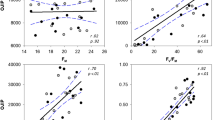Abstract
Photosynthetic efficiency is increasingly recognized as an integration of plant responses to dynamic environments, establishing the need for data sets from both field trials and controlled environments. A robotic field scanner phenoty** platform at the University of Arizona is equipped with a high-throughput chlorophyll fluorescence imaging system capable of collecting data on field trials for genetic studies of a photosynthetic trait (Fv/Fm). A description of the fluorescence imaging system is provided in addition to methods for measurements across experimental field plots and a test to determine the impact of variable plant heights. The overall focus is on aspects of field applications of a chlorophyll fluorescence imaging system that differ from analogous systems in controlled environments.
Access this chapter
Tax calculation will be finalised at checkout
Purchases are for personal use only
Similar content being viewed by others
References
Murchie EH, Lawson T (2013) Chlorophyll fluorescence analysis: a guide to good practice and understanding some new applications. J Exp Bot 64:3983–3998
Harbinson J, Prinzenberg AE, Kruijer W et al (2012) High throughput screening with chlorophyll fluorescence imaging and its use in crop improvement. Curr Opin Biotechnol 23:221–226
Murchie EH, Kefauver S, Araus JL et al (2018) Measuring the dynamic photsynthome. Ann Bot 122:207–220
van Bezouw RFHM, Keurentjes JJB, Harbinson J et al (2019) Converging phenomics and genomics to study natural variation in plant photosynthetic efficiency. Plant J 97:112–133
Oxborough K (2004) Imaging of chlorophyll a fluorescence: theoretical and practical aspects of an emerging technique for the monitoring of photosynthetic performance. J Exp Bot 55:1195–1205
Baker NR (2008) Chlorophyll fluorescence: a probe of photosynthesis in vivo. Ann Rev Plant Biol 59:89–113
Henriques FS (2009) Leaf chlorophyll fluorescence: background and fundamentals for plant biologists. Bot Rev 75:249–270
Björkman O, Demmig B (1987) Photon yield of O2 evolution and chlorophyll fluorescence characteristics at 77 K among vascular plants of diverse origins. Planta 170:489–504
Nedbal L, Whitmarsh J (2004) Chlorophyll fluorescence imaging of leaves and fruits. In: Papageorgiou GC, Govindjee R (eds) Chlorophyll fluorescence: a signature of photosynthesis. Kluwer Academic Publishers
Lawson T, Vialet-Chabrand (2018) Chlorophyll fluorescence imaging. In: Covshoff S (ed) Photosynthesis methods and protocols. Humana Press, New York
Acknowledgments
The development of methods and tests using the field chlorophyll fluorescence imaging system are the results of a group effort by the larger TERRA-REF project team and especially Tino Dornbusch, Robert Strand, John Huen, Jeffrey Demieville, and Matthew Herritt. This work is part of the TERRA program supported by the Advanced Research Projects Agency-Energy (ARPA-E), US Department of Energy, under Award Number DE-AR0000594. The views and opinions of authors expressed herein do not necessarily state or reflect those of the US government or any agency thereof.
Author information
Authors and Affiliations
Corresponding author
Editor information
Editors and Affiliations
Rights and permissions
Copyright information
© 2022 The Author(s), under exclusive license to Springer Science+Business Media, LLC, part of Springer Nature
About this protocol
Cite this protocol
Newcomb, M., Shakoor, N. (2022). Nighttime Chlorophyll Fluorescence Imaging of Dark-Adapted Plants Using a Robotic Field Phenoty** Platform. In: Lorence, A., Medina Jimenez, K. (eds) High-Throughput Plant Phenoty**. Methods in Molecular Biology, vol 2539. Humana, New York, NY. https://doi.org/10.1007/978-1-0716-2537-8_17
Download citation
DOI: https://doi.org/10.1007/978-1-0716-2537-8_17
Published:
Publisher Name: Humana, New York, NY
Print ISBN: 978-1-0716-2536-1
Online ISBN: 978-1-0716-2537-8
eBook Packages: Springer Protocols




